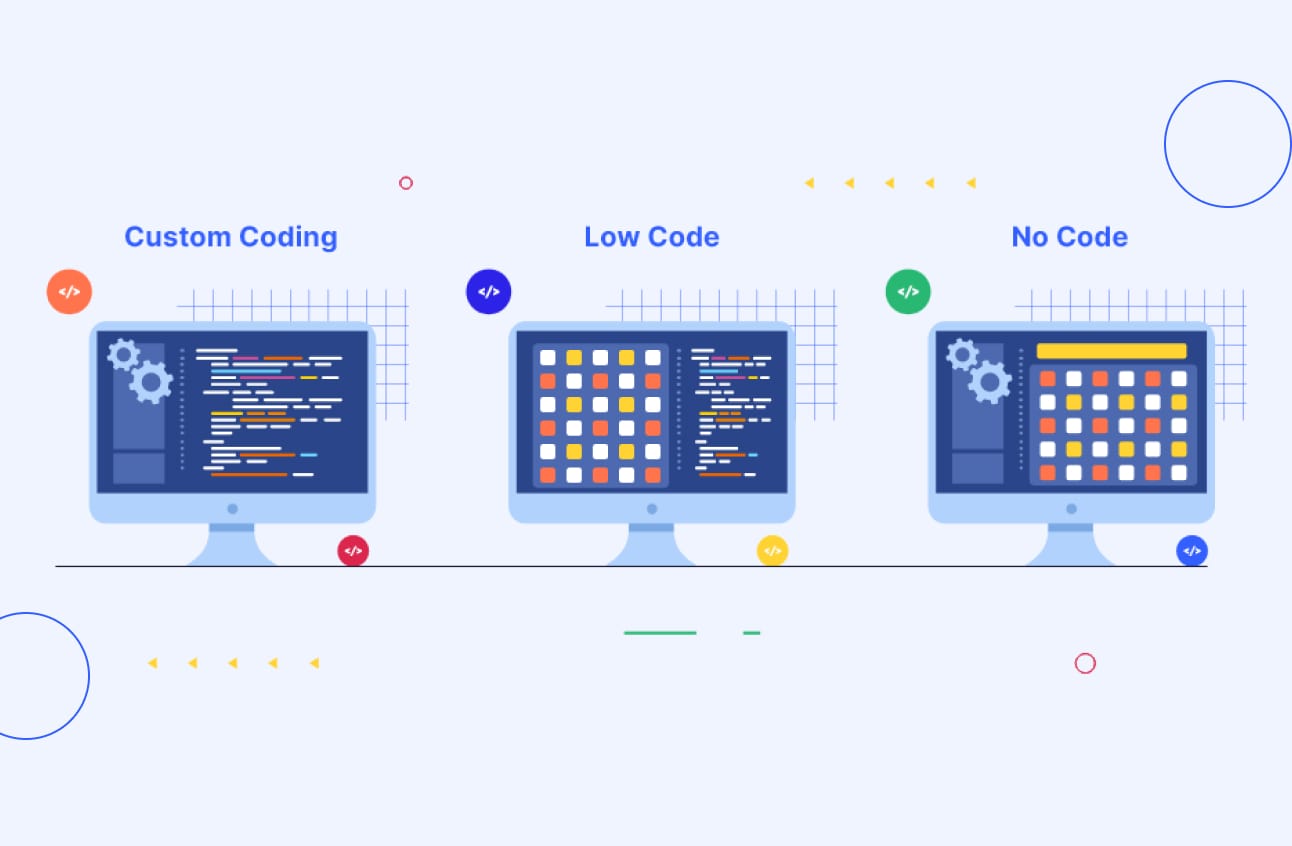Did you know that 70% of the applications will rely on low-code or no-code development by 2025? That indicates a huge shift in how businesses design and develop build applications today.
Today, businesses have more options than ever to bring their creative app ideas to life in ways that give the best returns on investment. From low code and no-code platforms for speed and cost-savings to custom code for desired features, it’s only natural to feel overwhelmed when making a choice.
In this guide, we’ll break down all you need to know about low code, no code, and custom code to decide which approach works best for your business. Let’s begin.
What Are Low-Code, No-Code, and Custom Code?

Technically, low-code, no-code, and custom code are different approaches to developing software applications. The first two methods work without coding expertise, while the custom code relies on traditional coding to build applications. To make things simpler, let’s break down the three methods:
What is No-Code Development?
No-code development lets you create apps without knowing much about programming or coding. This helps build multiple applications, websites, or prototypes in a super user-friendly manner. If you aren’t tech-savvy or know little about coding, the no-code method is an incredible way to make something simple and fast.
Fortunately, multiple no-code development tools let users use visual drag-and-drop to build basic apps that breathe life into their ideas. Some of these tools include Wix, Bubble, and Zapier, handling it all for you without writing traditional code.
What is Low-Code Development?
Low-code development is a methodology that’s both simple and flexible. Simply put, it uses minimal hand-coding, allowing users to tweak and customize the software for complex needs. As the name implies, low code is best for businesses that need something that fits their needs without complicating the development!
Although it requires some coding for special instructions, you don’t need to be an expert in the area to develop a fully functional app. Tools like OutSystems and Mendix are fantastic examples of low-code platforms that give you the best possible outcomes with little coding knowledge.
What is Custom Code Development?
Unlike no-code or low code development, custom code development refers to building solutions from the ground up. This approach involves professional developers to get the details right, ensuring every function of the app serves the business needs. They write code to design and build software with features specifically designed for a business.
Evidently, it’s a great choice for large-scale, complex systems that require tailored functions. The top examples of custom code designs include apps built with React, Laravel, or Python - all of which take considerable time to get the app working in full swing.
Key Differences Between Low-Code, No-Code, and Custom Code
Now that we’ve covered the basics, it’s time to dig into no code vs low code and how they differ from custom code. Knowing the key differences beforehand helps you figure out which option works best for your business. Here’s how they differ:

1. Development Speed
Generally, no-code and low-code approaches use pre-built features and drag-and-drop interfaces to create apps or websites. This means they let you create apps in no time without getting tangled up in technical details. While low-code is a bit slower than no-code, it’s still much faster than traditional development.
Custom code, on the flip side, is built from scratch, which means that developers need to create, test, and refine each feature before the app starts working. Longer timelines mean slower speed.
2. Cost
When it comes to cost, no-code solutions are the most affordable. They’re best for startups or businesses who don’t want to spend much on their development processes.
Low-code options sit somewhere in the middle, which makes them great for firms with a small development budget. Since custom code requires extensive coding knowledge, it’s the most expensive. But if you’re a unique business with complex needs, it’s generally worth the investment!

3. Scalability
Scalability is yet another key factor that sets these development methods apart from one another. For example, no-code is great for smaller projects but doesn’t scale well as your business expands. While low code is a step ahead in terms of scalability, it still doesn’t suffice for large-scale projects or businesses.
That’s where custom code steps in, letting businesses expand their operations just as much as they want. It handles everything from advanced features to growing demand, aiding in scaling your business.

4. Flexibility & Customization
Goes without saying that flexibility and customization are where these development approaches differ the most. No-code entirely relies on pre-built templates, which limits all your personalization efforts. Low-code offers customization to some extent but still has its boundaries.
Luckily, custom code allows you complete freedom, letting you develop an application without any limitations with all the features you desire.
5. Maintenance & Updates
With no code, the platform’s pre-built features take care of the maintenance and updates for you. However, you’re not free to choose the schedule or your desired updates. Low-code makes maintenance simpler with built-in tools designed to handle it for you.
On the other hand, custom code requires field expertise, which you need to approach with the right skillset or outsource. Nonetheless, this approach gives you more control over how and when the changes are made.
When to Choose No-Code, Low-Code, or Custom Code

Now, you’re probably wondering when to go for no-code, low-code, or custom code. Well, that depends on different scenarios and, of course, your business requirements. To simplify, here’s when you should use each of the three coding platforms:
1. Choose No-Code If:
You’re a small business or a startup with limited funding options. With no-code platforms, you can set up a quick MVP or website to set things up initially.
Plus, when your team lacks the technical expertise to build a solid platform, you can rely on the built-in features of the no-code platforms. Usually, these platforms help build small e-commerce stores, craft blogs, or event landing pages. This is especially great if you don’t have an in-house development team yet.
2. Choose Low-Code If:
When looking for some custom features without investing too much, low-code is the way to go. It doesn’t just offer you more personalization but also has faster turnaround times, unlike custom codes, where you’ve got to build everything from scratch. This is the ideal approach when you have moderately complex workflows or integrations.
The best examples of a low-code approach include mid-sized businesses creating internal tools or customer portals with multiple built-in features.
3. Choose Custom Code If:
If your business is a high-scale one requiring highly specific or complex applications, custom code is the best approach for you. While you might need to set aside a significant budget for it, the results pay off in more ways than one. Plus, custom code is perfect if your business seeks scalability, performance, and other security features.
Typically, large-scale e-commerce platforms, SaaS products, or enterprise solutions rely on custom get to get desired features within their custom applications.
Challenges and Limitations

Like everything else, code platforms come with their fair share of challenges and limitations. Here are a few of them to keep in mind before you opt for any of the three codes for your business:
1. No-Code Challenges
While no-code is super cost-friendly and quick, it lacks the customization option, which often hinders your stability in the long run. Plus, this way, you’re only dependent on the platform provider for upgrades or maintenance. The result? Businesses no longer remain self-sufficient.
2. Low-Code Challenges
Although they offer some degree of customization, low-code platforms require some learning for non-technical users. They aren’t always suitable for complex applications. These limitations hinder a business’s operations and, hence, its growth in the long run.
3. Custom Code Challenges
Unsurprisingly, custom code comes with super high initial costs and longer development times. Developers need longer timelines to code and design in ways that fit the business’s functions. Plus, it requires technical expertise for updates and maintenance.
FAQs
1. What are the Advantages of Custom Code?
The biggest perks of custom code are that they offer flexibility and freedom of customization. Since developers have full control over the features they build from scratch, the business can add features that fit their operations perfectly.
2. How Can I Choose the Right Development Platform?
When choosing the development platform, it’s important to think about scalability, ease of use, and overall performance to ensure it fits your business’s needs just right.
3. Which Businesses Typically Use No-Code Development?
Typically, startups use no-code development, especially if they lack the budget or expertise to develop software with their desired features. Such businesses use no-code platforms without relying on their IT team.
Conclusion
When it comes to choosing the right code, there’s no one-size-fits-all answer. Whether you’re choosing no code, low code, or custom code, it’s always worth taking time out to figure out the right choice and save hassles down the road. Once you know what aligns with your business perfectly, you’re golden.
Still unsure which solution is right for your business? Contact CodeBudee Solutions for expert guidance on no-code, low-code, and custom development tailored to your needs.


